小学英语句型结构练习!!
小学英语句型详解之祈使句
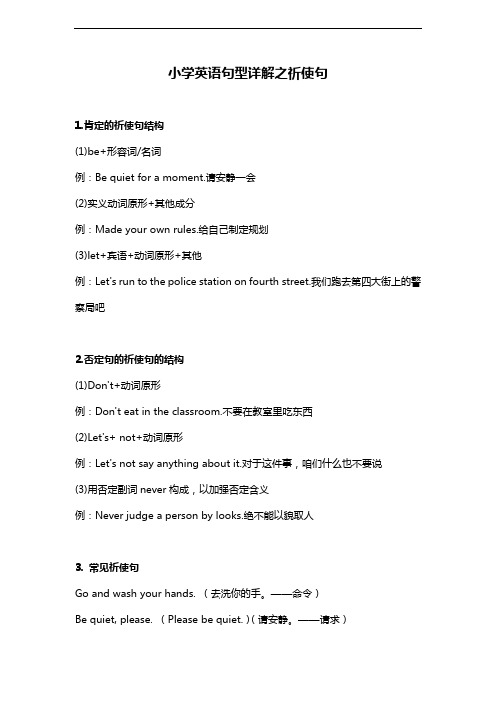
小学英语句型详解之祈使句1.肯定的祈使句结构(1)be+形容词/名词例:Be quiet for a moment.请安静一会(2)实义动词原形+其他成分例:Made your own rules.给自己制定规划(3)let+宾语+动词原形+其他例:Let's run to the police station on fourth street.我们跑去第四大街上的警察局吧2.否定句的祈使句的结构(1)Don't+动词原形例:Don't eat in the classroom.不要在教室里吃东西(2)Let's+ not+动词原形例:Let's not say anything about it.对于这件事,咱们什么也不要说(3)用否定副词never构成,以加强否定含义例:Never judge a person by looks.绝不能以貌取人3. 常见祈使句Go and wash your hands. (去洗你的手。
——命令)Be quiet, please. (Please be quiet.)(请安静。
——请求)Be kind to our sister. (对我们的姐妹们要和善。
——劝告)Watch your steps. (走路小心。
——警告)Look out!Danger!(小心!危险!——强烈警告,如感叹句)Keep off the grass. (勿践草坪。
——禁止)No parking. (禁止停车。
——禁止)No eating or drinking. (禁止吃喝。
——禁止)No littering. (禁止乱扔垃圾。
——禁止)4. 祈使句口诀祈使句无主语,主语you常省去;动词原形当谓语,Don't句首变否定;朗读应当用降调,句末常标感叹号。
译林版小学英语句子类型及句式变形和一些练习
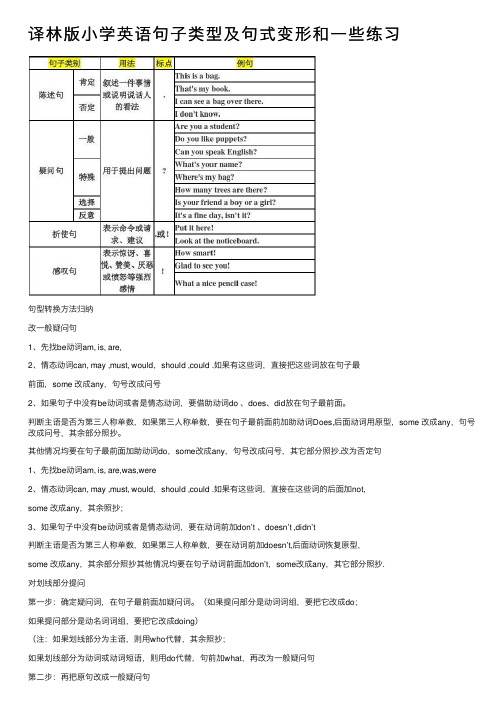
译林版⼩学英语句⼦类型及句式变形和⼀些练习句型转换⽅法归纳改⼀般疑问句1、先找be动词am, is, are,2、情态动词can, may ,must, would,should ,could .如果有这些词,直接把这些词放在句⼦最前⾯,some 改成any,句号改成问号2、如果句⼦中没有be动词或者是情态动词,要借助动词do 、does、did放在句⼦最前⾯。
判断主语是否为第三⼈称单数,如果第三⼈称单数,要在句⼦最前⾯前加助动词Does,后⾯动词⽤原型,some 改成any,句号改成问号,其余部分照抄。
其他情况均要在句⼦最前⾯加助动词do,some改成any,句号改成问号,其它部分照抄.改为否定句1、先找be动词am, is, are,was,were2、情态动词can, may ,must, would,should ,could .如果有这些词,直接在这些词的后⾯加not,some 改成any,其余照抄;3、如果句⼦中没有be动词或者是情态动词,要在动词前加don’t 、doesn’t ,didn’t判断主语是否为第三⼈称单数,如果第三⼈称单数,要在动词前加doesn’t,后⾯动词恢复原型,some 改成any,其余部分照抄其他情况均要在句⼦动词前⾯加don’t,some改成any,其它部分照抄.对划线部分提问第⼀步:确定疑问词,在句⼦最前⾯加疑问词。
(如果提问部分是动词词组,要把它改成do;如果提问部分是动名词词组,要把它改成doing)(注:如果划线部分为主语,则⽤who代替,其余照抄;如果划线部分为动词或动词短语,则⽤do代替,句前加what,再改为⼀般疑问句第⼆步:再把原句改成⼀般疑问句常⽤疑问词:什么时间问时间什么时间问具体时间,如⼏点钟谁问⼈谁的问主⼈在哪⾥问地点哪⼀个问选择为什么问原因什么问东西、事物什么颜⾊问颜⾊。
怎么样问意见星期⼏问星期⼏什么⽇期问⽇期为何⽬的问⽬的。
怎样问情况多⼤年纪问年纪多少数量(可数名词)问数量多少钱;多少数量(不可数名词)问多少钱或数量(不可数)。
小学五年级英语一般现在时和现在进行时句型练习

选择疑问句: Do you like
apples or bananas?
反义疑问句: You like apples,
don't you?
现在进行时句 型
主语+be动词(am/is/are)+动词ing形式+其 他
主语+be动词(am/is/are)+动词ing形式+其他
谓语动词必须是动词ing形式
疑问句句型
一般疑问句:be动词/助动词/情态动词+主语+谓语+其他?
特殊疑问句:特殊疑问词+be动词/助动词/情态动词+主语+谓语+其他?
选择疑问句:be动词/助动词/情态动词+主语+谓语(+其他)+or+谓语(+其他)?
反义疑问句:be动词/助动词/情态动词+主语+谓语(+其他)+,aren主语+谓语(+ 其他)?
现在进行时表示正在进行的动作或状态
常与now、at the moment等时间状语连用
主语+be动词(am/is/are)+动词ing形式+地 点
主语+be动词(am/is/are)+动词ing形式+地点
表达正在进行的动作或状态
通常与now、at the moment等时间状语连用
结构:主语+be动词+动词ing+地点
时间状语:always, usually, often, sometimes, every day等
否定句形式:主语 +don't/doesn't+动词原形+ 其他
小学英语There be句型语法讲义+专项练习(附答案)

小学英语There be句型语法讲义+专项练习(附答案)要点讲练There be句型也叫作存在句,它是英语中一种常见的句型结构,表示在某地存在某物(某人)或在某时发生某事一、There be 句型结构1、there be 结构的肯定句(1)There is+可数名词单数/不可数名词+地点/时间状语Eg. There is a flower in the bottle. 瓶里有一朵花。
There is some money in the purse. 钱包里有些钱。
(2)There are+可数名词复数+地点/时间状语Eg. There are many books in the shelf. 书架上有一些书。
2、there be 结构的否定句there be 结构的否定句是在be 后加"not"或"no",表示“没有”之意。
如果句中有some,变否定句时需将some变为any。
Eg. There are not any/no flowers in the vast.花瓶里没有花。
3、there be 结构的疑问句(1)一般疑问句及其答语there be 结构的一般疑问句通常是把be提至there前,首字母大写,句末用问号,其肯定的回答为"Yes,there is/are",否定回答为"No,there isn’t/aren’t"。
Eg. -Is there a computer in your room? 你房间里有电脑吗?-Yes,there is/ No,there isn’t 是的,有。
/不,没有。
(2)特殊疑问句及其回答①提问句子的主语(包括主语前的修饰语)时,句型一律用"what is + 地点介词短语?"(无论主语是单数还是复数都用is)。
Eg. There are some birds in the tree. →What's in the tree?②就there be后面的地点状语进行提问时,句型用"where is / are + 主语?"如:There is a car in the street. →Where is the car?③提问可数名词(主语)前的数量时,用how many,句型结构为"how many + 复数名词+ are there + 其它?"(主语无论是单数还是复数,be通常要用are)。
五年级下册英语知识讲义 句型专项训练(下) 湘少版(三起)
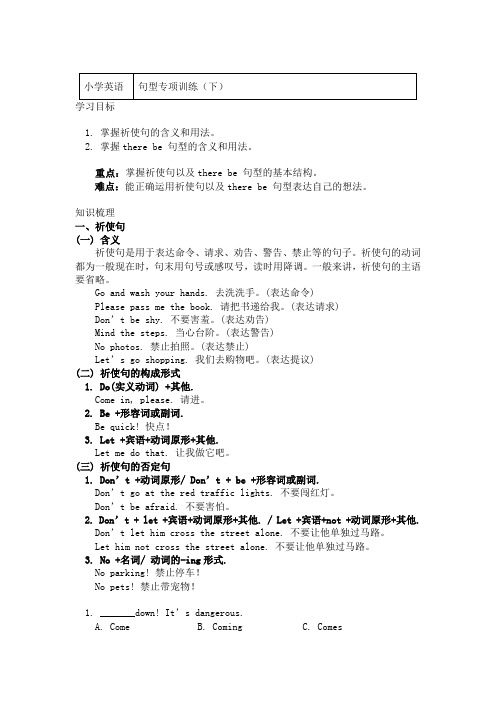
1. 掌握祈使句的含义和用法。
2. 掌握there be 句型的含义和用法。
重点:掌握祈使句以及there be 句型的基本结构。
难点:能正确运用祈使句以及there be 句型表达自己的想法。
知识梳理一、祈使句(一) 含义祈使句是用于表达命令、请求、劝告、警告、禁止等的句子。
祈使句的动词都为一般现在时,句末用句号或感叹号,读时用降调。
一般来讲,祈使句的主语要省略。
Go and wash your hands. 去洗洗手。
(表达命令)Please pass me the book. 请把书递给我。
(表达请求)Don’t be shy. 不要害羞。
(表达劝告)Mind the steps. 当心台阶。
(表达警告)No photos. 禁止拍照。
(表达禁止)Let’s go shopping. 我们去购物吧。
(表达提议)(二) 祈使句的构成形式1. Do(实义动词) +其他.Come in, please. 请进。
2. Be +形容词或副词.Be quick! 快点!3. Let +宾语+动词原形+其他.Let me do that. 让我做它吧。
(三) 祈使句的否定句1. Don’t +动词原形/ Don’t + be +形容词或副词.Don’t go at the red traffic lights. 不要闯红灯。
Don’t be afraid. 不要害怕。
2. Don’t + let +宾语+动词原形+其他. / Let +宾语+not +动词原形+其他.Don’t let him cross the street alone. 不要让他单独过马路。
Let him not cross the street alone. 不要让他单独过马路。
3. No +名词/ 动词的-ing形式.No parking! 禁止停车!No pets! 禁止带宠物!1. _______down! It’s dangerous.A. ComeB. ComingC. Comes答案:A思路分析:本句是祈使句,故动词用原形,故选A项。
小学英语单词短语句型加练习
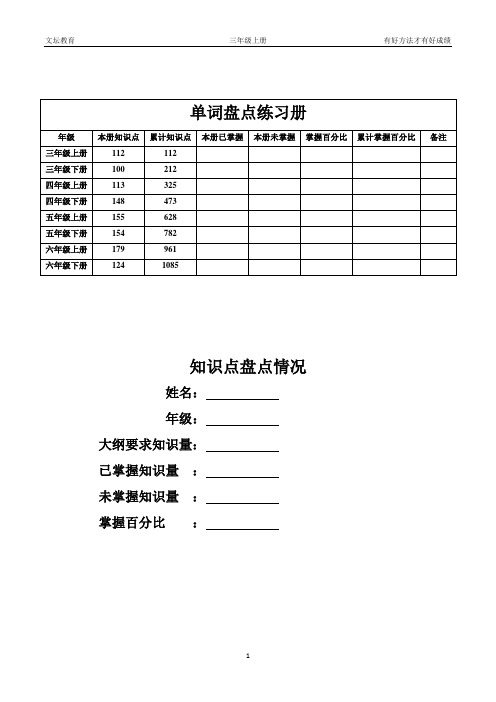
知识点盘点情况姓名:年级:大纲要求知识量:已掌握知识量:未掌握知识量:掌握百分比:目录三年级上册 (3)三年级下册 (11)四年级上册 (19)四年级下册 (27)五年级上册 (35)五年级下册 (47)六年级上册 (56)六年级下册 (64)人教版小学英语三年级上册Unit 1单词(20个/20个)ruler['ru:lə(r)]尺子pencil['pensl]铅笔eraser[i'reɪzə(r)]橡皮crayon['kreɪən]蜡笔bag[bæɡ]包pen[pen]钢笔pencil-case['pensl,keɪs]铅笔盒pencil box['pensl,bɒks]铅笔盒book[bʊk]书no[nəʊ]不your[jɔ:(r)]你(们)的Unit 1常用表达I'm hungry. 我很饿。
Hello,I'm Wu Yifan. 你好,我是吴一凡。
Hi,I'm Sarah. 你好,我是萨拉。
What's your name? 你叫什么名字?My name's John. 我叫约翰。
Goodbye! 再见!Bye,Miss White. 再见,怀特小姐Who's there? 那边是谁?Let's play. 让我们玩吧(开始吧)。
Unit 2单词(18个/48个)red[red]红色;红色的green[ɡri:n]绿色;绿色的yellow['jeləʊ]黄色;黄色的blue[blu:]蓝色;蓝色的black[blæk]黑色;黑色的brown[braʊn]棕色;棕色的white[waɪt]白色;白色的orange['ɔrɪndʒ]橙色;橙色的OK[əʊ'keɪ]好;行mum [mʌm]妈妈(美式英语:mom/mɒm/)Unit 2常用表达Mr Jones,this is Miss Green.琼斯先生,这是格林小姐。
小学英语句型结构练习!!
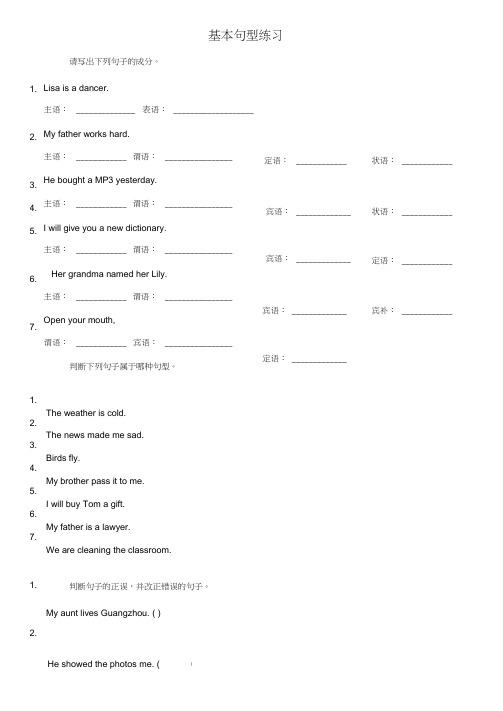
5.Look, you, happy.
6.am, I, heavier, you, than.
7.young, is, she.
8.Win, I, the, game.
9.Headache, he, has.
10.Went, park, to, the, last, night.
二、完成句子。
1.students.他们是学生。
2.Iswimming.我喜欢游泳。
3.and他.既高又壮。
4.Shelast ni ght.她昨晚看电视。
5.Miபைடு நூலகம்e ofte non Sun days迈克经常在周日踢足球。
6.Maryt h a n me.玛丽比我矮。
7.isnow.他的妈妈现在在打扫房
间。
8.You cannow.你现在可以回家了。
9.Jackin She nya ng杰克住在沈阳。
10.We areBe i j i n g tomorrow.我们打算明天去北京。
主语:谓语:
Open your mouth,
谓语:宾语:
判断下列句子属于哪种句型。
The weather is cold.
The news made me sad.
Birds fly.
My brother pass it to me.
I will buy Tom a gift.
My father is a lawyer.
请写出下列句子的成分。
基本句型练习
Lisa is a dancer.
主语:表语:
My father works hard.
PEP小学六年级英语there_be_句型讲解与练习学习资料-2022年学习资料

选择填空-1There A a-a clock on the table.-A.is-B.are-2B-3 there a radio on your desk-A.are B.is-3C there a map n the wall?Yes,there-A.are/is-B.is /are-C.is/is-D.are /are-4There-some students in the classroom-5There Aa encil,a book and two pens on the-table:
就近原则:-mere-是个近视眼-只要看到be动词后面的词是-复数名词就用are,-否则就用is不可数也用 s-当然还要注意时态哦!
There is a cat under the tree.-There are two dogs und r the tree-There is a cat and two dogs under the tree -There are two dogs and acat under the tree
There is//arenot.可表达什么爪-事物不存在。-瓶里一朵花也没有-There is not flower in the bottle-钱包里没有钱-There is not some money n the purse-黑板上没有字。-There are no words on the blackbo r-山e以取价
There be句型句式:-There be:某地有(存在)某人或某物-其中be动词有时态和单复数变化-T ere be+某人/某物-1.There is+单数名词/不可数名词+地点-2.There are+复数名 +地点
PEP小学六年级英语there-be-句型讲解与练习
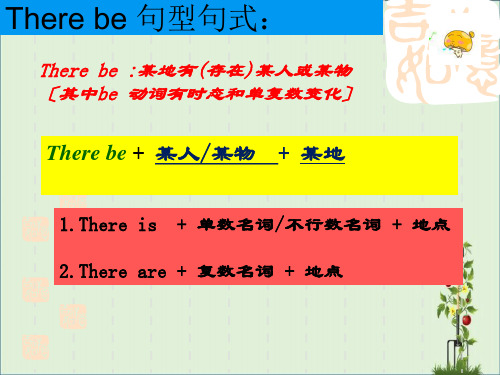
A. some, not
B. some, any
C. any, not
D. any, no
11〕There ____a desk and fifty-five chairs in
the classroom.
A. are
B. is
12〕There ___ fifty-five chairs and a desk in the
4〕There __A___ some students in the classroom. A. are B. is
5〕There __A___ a pencil, a book and two pens on the
table.
A.is
B. are
6〕There __B_ two apples, one orange and one banana
15〕There _____ a pencil-case and many pencils in Tom’s schoolbag. A. is B. are C. have D. be
16〕 There _____ a doll in the toy box.
A. is
B. are
17〕There _____ some bread on the plate.
3〕There were a lot of rain here last month. (was )
4〕Is there any chairs in the room?
( Are )
5〕Are there some clouds in the sky? ( any )
按要求改写句子
1〕There are a few parks nearby. (改写为否认句) .
五种基本句型(含练习和答案)

. .五种基本句型,似千乎,有简有繁句子是由主语、谓语动词、表语、宾语、宾语补足语等组成的。
英语句子有长有短大、组合、变万化,难以捉摸,但其实只有五种基本句型。
所有英语句子都可以看成是这五种基本句型的扩省略或倒装。
因此掌握这五大句型,是掌握其他各种英语句子结构的基础。
英语句子依其组合方式可分为以下五种基本句型,句子成分的表示法为:S:Subject (主语) , V:Verb(动词),O: Object (宾语), IO : Indirect Object ( 间接宾语), DO: Direct Object ( 直接宾语) , P :Predicative (表语), OC :Object Complement (宾语补足语)。
五种基本句型见下表(S=主,V=谓, O=宾, P=表, IO=间宾,DO=直宾,OC=宾补):种类句型例句第 1 种S+V We work. ( 不及物)第 2 种S+V+O He plays ( 及物 ) the piano.第 3 种S+V+P We are( 系动词 ) students.第 4 种S+V+IO+DO She gave( 及物 ) me a pen.第 5 种S+V+O+OC He made(及物 ) the boy laugh.一、第 1 种句型:S+V(主语 +不及物动词)1、 Birds fly. 鸟飞。
主语+谓语(不及物动词)2、 He runs in the park. 他在公园里跑。
主语+谓语+地点状语( 不及物动词)此句型是“主语+不及物动词”构成句子的主体部分。
因为是不及物动词,后面当然不能带宾语了,但是可以有状语来修饰。
例如上面例句中的in the park 就是地点状语。
了3、Class begins. (begin 在句中是不及物动词)上课比较: We begin our class at eight. 我们八点钟开始上课。
人教版小学英语五年级上册 句型练习
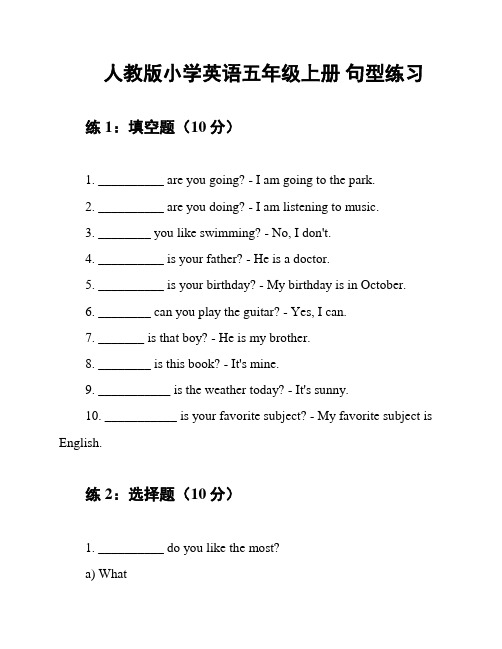
人教版小学英语五年级上册句型练习练1:填空题(10分)1. __________ are you going? - I am going to the park.2. __________ are you doing? - I am listening to music.3. ________ you like swimming? - No, I don't.4. __________ is your father? - He is a doctor.5. __________ is your birthday? - My birthday is in October.6. ________ can you play the guitar? - Yes, I can.7. _______ is that boy? - He is my brother.8. ________ is this book? - It's mine.9. ___________ is the weather today? - It's sunny.10. ___________ is your favorite subject? - My favorite subject is English.练2:选择题(10分)1. __________ do you like the most?a) Whatb) Whoc) Howd) Why2. __________ is your mother? - She is a teacher.a) Whichb) Wherec) Whosed) What3. __________ is your birthday? - It's on June 10th.a) Whenb) Whyc) Whod) How4. ____________ your brother like playing basketball?a) Areb) Doc) Isd) Does5. ____________ are you? - I'm 10 years old.a) Howb) Whatc) Whod) Whose6. ____________ is your favorite color? - My favorite color is blue.a) Whenb) Wherec) Whatd) Why7. ____________ are they doing? - They are playing football.a) Whatb) Whenc) Whered) How8. ____________ are you going? - I am going to the supermarket.a) Whob) Wherec) Whend) Why9. ____________ is that girl? - She is my friend.a) Whatb) Whoc) Whosed) Where10. ____________ is your favorite food? - My favorite food is pizza.a) Whob) Whatc) Whered) How练3:将下列句子改为否定句(10分)1. I am reading a book.2. Mary can swim.3. The cat is sleeping.4. David likes playing football.5. They are going to the park.6. My brother is nine years old.7. We have two dogs.8. She is a doctor.9. He has a big house.10. The weather is nice today.练4:根据图片选择合适的句子(10分)1. __________2. __________3. __________4. __________5. __________练5:连词成句(10分)1. are, where, going, you, ?2. can, play, piano, the, she, .3. swimming, doesn't, like, he, .4. is, your, what, favorite, color, ?5. doing, what, he, is, ?练6:阅读理解(20分)Read the passage and answer the questions.Mary is a 10-year-old girl. She is from England. She has a pet dog named Jack. Jack is a black Labrador. Mary likes playing with Jack in the park. Her favorite color is blue. Mary can play the piano. She takes piano lessons twice a week. She also likes swimming.1. Where is Mary from?2. What is the name of Mary's pet dog?3. What color does Mary like?4. How often does Mary take piano lessons?5. What else does Mary like besides playing the piano? 参考答案练1:填空题1. Where2. What3. Do4. What5. When6. Where7. Who8. Whose9. What10. What练2:选择题1. d) Why2. b) Where3. a) When4. d) Does5. a) How6. c) What7. a) What8. b) Where9. b) Who10. b) What练3:将下列句子改为否定句1. I am not reading a book.2. Mary can't swim.3. The cat is not sleeping.4. David doesn't like playing football.5. They are not going to the park.6. My brother is not nine years old.7. We don't have two dogs.8. She is not a doctor.9. He doesn't have a big house.10. The weather is not nice today.练4:根据图片选择合适的句子1. The boy is playing soccer.2. The girl is reading a book.3. The cat is sleeping.4. The man is driving a car.5. The woman is cooking.练5:连词成句1. Where are you going?2. She can play the piano.3. He doesn't like swimming.4. What is your favorite color?5. What is he doing?练6:阅读理解1. Mary is from England.2. The name of Mary's pet dog is Jack.3. Mary likes the color blue.4. Mary takes piano lessons twice a week.5. Besides playing the piano, Mary also likes swimming.。
小学英语肯否一特四种句型详解及精编练习题精排版!!!
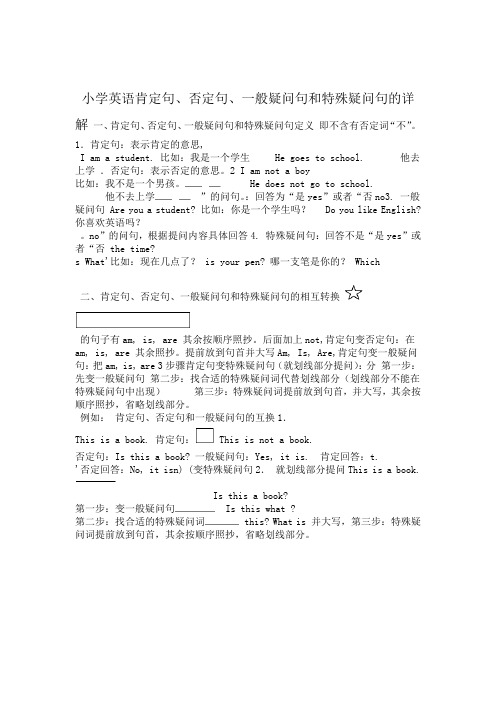
小学英语肯定句、否定句、一般疑问句和特殊疑问句的详解一、肯定句、否定句、一般疑问句和特殊疑问句定义即不含有否定词“不”。
1.肯定句:表示肯定的意思,I am a student. 比如:我是一个学生 He goes to school. 他去上学.否定句:表示否定的意思。
2 I am not a boy比如:我不是一个男孩。
He does not go to school.他不去上学”的问句。
:回答为“是yes”或者“否no3. 一般疑问句 Are you a student? 比如:你是一个学生吗? Do you like English? 你喜欢英语吗?。
no”的问句,根据提问内容具体回答4. 特殊疑问句:回答不是“是yes”或者“否 the time?s What'比如:现在几点了? is your pen? 哪一支笔是你的? Which 二、肯定句、否定句、一般疑问句和特殊疑问句的相互转换的句子有am, is, are 其余按顺序照抄。
后面加上not,肯定句变否定句:在am, is, are 其余照抄。
提前放到句首并大写Am, Is, Are,肯定句变一般疑问句:把am, is, are 3步骤肯定句变特殊疑问句(就划线部分提问):分第一步:先变一般疑问句第二步:找合适的特殊疑问词代替划线部分(划线部分不能在特殊疑问句中出现)第三步:特殊疑问词提前放到句首,并大写,其余按顺序照抄,省略划线部分。
例如:肯定句、否定句和一般疑问句的互换1.This is a book. 肯定句:This is not a book.否定句:Is this a book? 一般疑问句:Yes, it is. 肯定回答:t.'否定回答:No, it isn) (变特殊疑问句2.就划线部分提问This is a book.Is this a book?第一步:变一般疑问句 Is this what ?第二步:找合适的特殊疑问词this? What is 并大写,第三步:特殊疑问词提前放到句首,其余按顺序照抄,省略划线部分。
人教精通版小学英语三年级上册重要词语及句型
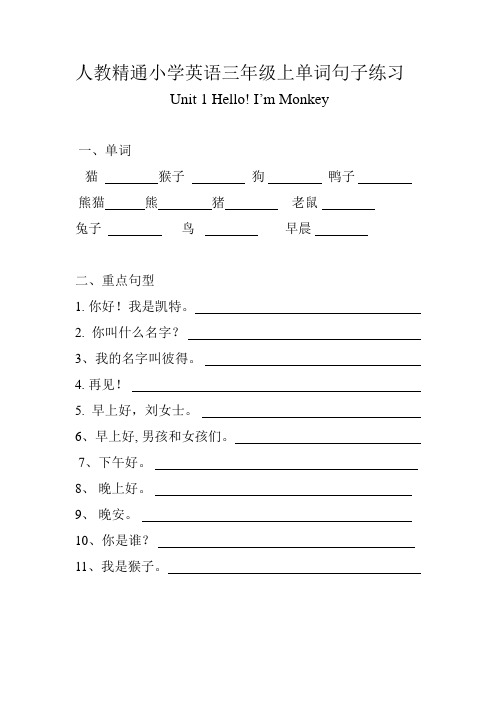
人教精通小学英语三年级上单词句子练习Unit 1 Hello! I’m Monkey一、单词猫猴子狗鸭子熊猫熊猪老鼠兔子鸟早晨二、重点句型1. 你好!我是凯特。
2. 你叫什么名字?3、我的名字叫彼得。
4. 再见!5. 早上好,刘女士。
6、早上好, 男孩和女孩们。
7、下午好。
8、晚上好。
9、晚安。
10、你是谁?11、我是猴子。
Unit 2 This is my pencil.一、单词书书包钢笔铅笔铅笔盒尺橡皮卷笔刀胶棒马克笔二、重点句型1、很高兴见到你。
2、我也很高兴见到你。
3. 欢迎!4. 打开你的铅笔盒。
5. 拿出你的尺。
6. 给我看看你的铅笔。
7. 指着你的钢笔。
8. 这是我的橡皮。
9. 哇!太好看了。
10. 看我的书。
11. 找出相同的一个。
12、再次见到你很高兴。
13、再次见到你也很高兴。
Unit 3 Look at my nose.一、单词鼻子眼睛脸头耳朵脖子胳膊手腿膝盖脚嘴二、重点句型1. 看我的鼻子。
哇!它是大的。
2. 碰碰你的鼻子。
3. 碰碰我的眼睛。
4. 他有一张大脸。
5. 你好吗?我很好,谢谢!6. 画一张脸,一个鼻子,两只眼睛和一张嘴。
7. 你好吗?不是很好。
8. 看我的胳膊!噢,太遗憾了。
9. 点点你的头。
10. 张开你的嘴。
11. 闭上你的眼。
12.摸摸你的脖子。
13. 拍拍你的手。
14. 挥挥你的胳膊。
Unit 4 I have a ball.一、单词娃娃球风筝汽球小汽车公共汽车自行车出租车火车轮船飞机小船二、重点句型1. 我有一个球。
2. 我有一个好看的娃娃。
3.多大啊!4. 放风筝。
5. 我有一辆新的小汽车。
6. 真的吗?7. 太好了。
8. 看这里。
9. 太酷了。
10. 我有一辆新自行车。
11、真的吗?我可以看看它吗?12、当然!给你。
13、谢谢你。
14、不客气。
Unit 5 What colour is it?一、单词红色蓝色黄色绿色紫色棕色白色黑色粉色桔色灰色二、重点句型1、它是什么颜色?红色和蓝色。
小学六年级英语复习资料句型及练习

陈述句 (一)陈述句的肯定式 陈述句的肯定式有以下两种形式: 1.主语+系动词+表语 2.主语+谓语+其他成分 (二)陈述句的否定式 陈述句的否定式有以下四种形式: 1.谓语动词是be 动词时,由“be+not ”否定形式。
2.词时,由“do /does/did+not ”构成否定形式。
3.谓语为“助动词/情态动词+实义动词”时,由“助动词/情态动词+not ”构成否定形式。
4.有些陈述句的否定式是用no ,nothing ,nobody 等表示否定意义的词构成的。
Nobody is in.没有人在家里。
疑问句 (一)一般疑问句 1.一般疑问句的肯定式 一般疑问句可以用肯定词yes 或否定词no 回答,朗读一般疑问句时用升调。
根据其谓语动词的区别,一般疑问句的肯定式有两种。
(1)谓语动词为be ,have ,助动词或情态动词时,一般疑问句中把谓语动词be ,have ,助动词或情态动词提到句子开头。
(2)谓语动词为实义动词时,一般疑问句的形式为“do /does/did+主语+动词原形”。
特殊疑问句是对句子中某一部分提问的疑问句。
常用疑问词what,who,whose,which,when,why,where,ho w 等引导。
特殊疑问句不用yes 或no 回答,而是要根据实际情况进行回答。
朗读特殊疑问句时通常用降调。
根据特殊疑问句在句子担当成分的不同,特殊疑问句的结构形式可分为两种。
1.一般情况下,特殊疑问句由“疑问词+一般疑问句”构成。
What do you do at home?你在家做什么?Which color do you like?你喜欢哪种颜色?2.疑问句作主语或主语的定语时,特殊疑问句词序与陈述句相同。
Who cooks meals in your home?你家里祈使句 一、祈使句的定义 祈使句是用来表示请求、命令、劝告、建议等的句子。
祈使句习惯上常常省略主语(以动词开头的句子),句末用感叹号或句号,朗读时一般用降调。
完整小学阶段therebe句型语法知识点及练习

【Star小学精品英语】培育孩子上名校—中山市纪雅教育培训中心·hashave、小学表示“有”的there be句型和用法:一、There be句型的动词的单复数必须依主语的变化而变化,在存在某物或某人,Be表示某个地方动词用are ; 动词用is ; 主语是复数,be be there be 句型中,主语是单数,be 动词的那个名词决定。
如有几件物品,be 动词根据最近There is a table in the room.如:房间里有一张桌子。
There are some tables in the room.房间里有一些桌子。
There is a bed and 2 tables in the room.房间里有一张床和两张桌子。
There be 句型的结构:二、地点状语单数可数名词/不可数名词(主语)+There is+ 书桌上有一把尺。
例:There is a ruler on the desk.瓶子里有一些水。
There is some water in the bottle.地点状语There are+复数可数名词(主语)+树上有四个苹果。
There are four apples on the tree. 例:公园里有许多花。
There are many flowers in the park.单数可数名词(主语)+V-ing+地点状语There is+树上有一只鸟正在唱歌。
例:There is a bird singing in the tree.There is a baby sleeping in the room. 房间里有一个宝宝正在睡觉。
复数可数名词(主语)+V-ing+地点状语There are+There are some birds singing in the tree. 例:树上有一些鸟正在唱歌。
There are two boys running on the street.街上有两个男孩正在奔跑。
小学英语一般现在时的句型结构 (1)
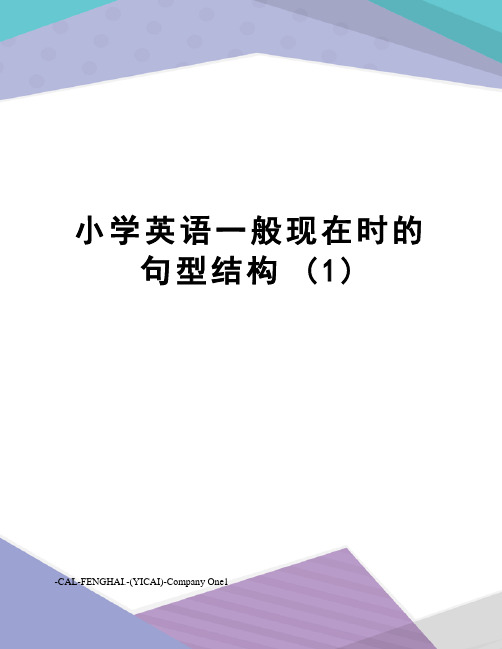
小学英语一般现在时的句型结构(1)-CAL-FENGHAI.-(YICAI)-Company One1小学英语一般现在时的句型结构1.肯定句构成:主语+动词 (注意人称变化) +其它成分I have a dog. We like the little cat. She sings well.2.否定句构成:行为动词的否定句:主语+助动词(do/does) + not +动词原形+其它成分He dosen’t have a dog.He isn’t young.We don’t like the little cat.3.一般疑问句:A.行为动词的一般疑问句:助动词(do/does)+主语+动词原形 + 其它成分Do you like it Yes, I do. / No. I don’t . Does he(she) like itYes, he( she )does. / No, he ( she )doesn’t.B. 动词BE 的一般疑问句Am / Is /Are +主语 + 其它成分Are you a teacher Yes, I am. / No, I am not.Is he your teacher?Yes,he is No,he is not.4.特殊疑问句:特殊疑问词What do you usually do on Sunday?专项语法练习(一般现在时)一、填写正确形式1.We often___________(play) on the playgound.2.__________you _________(brush) your teeth every morning.3. What____ (do) he usually _____(do) after school4.Danny _______(study) English, Chinese, Maths, Science and Art at school5. Mike sometimes __________(go) to the park with his sister.6.________ Mike________(read) English every day?7.What time ____his mother_________(teach) English8.We____ (not watch) TV on Monday.2。
小学英语肯否一特四种句型详解及精编练习题(精排版!!!)
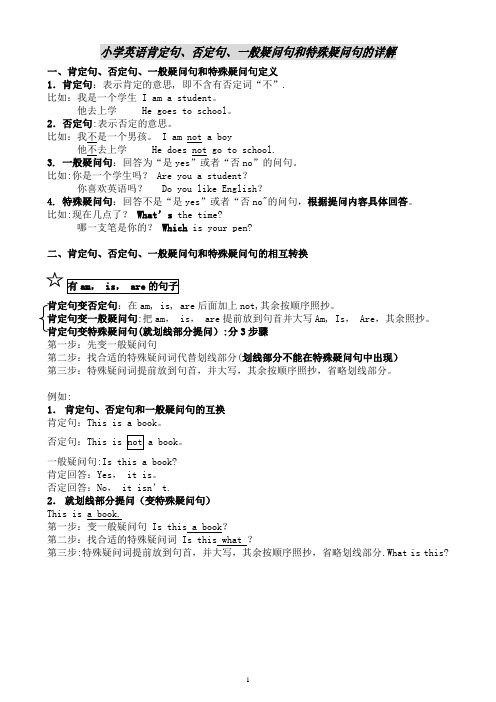
小学英语肯定句、否定句、一般疑问句和特殊疑问句的详解一、肯定句、否定句、一般疑问句和特殊疑问句定义1.肯定句:表示肯定的意思, 即不含有否定词“不”.比如:我是一个学生 I am a student。
他去上学 He goes to school。
2.否定句:表示否定的意思。
比如:我不是一个男孩。
I am not a boy他不去上学 He does not go to school.3. 一般疑问句:回答为“是yes”或者“否no”的问句。
比如:你是一个学生吗? Are you a student?你喜欢英语吗? Do you like English?4. 特殊疑问句:回答不是“是yes”或者“否no"的问句,根据提问内容具体回答。
比如:现在几点了?What’s the time?哪一支笔是你的?Which is your pen?二、肯定句、否定句、一般疑问句和特殊疑问句的相互转换肯定句变否定句:在am, is, are后面加上not,其余按顺序照抄。
肯定句变一般疑问句:把am, is, are提前放到句首并大写Am, Is, Are,其余照抄。
肯定句变特殊疑问句(就划线部分提问):分3步骤第一步:先变一般疑问句第二步:找合适的特殊疑问词代替划线部分(划线部分不能在特殊疑问句中出现)第三步:特殊疑问词提前放到句首,并大写,其余按顺序照抄,省略划线部分。
例如:1.肯定句、否定句和一般疑问句的互换肯定句:This is a book。
否定句:。
一般疑问句:Is this a book?肯定回答:Yes, it is。
否定回答:No, it isn’t.2.就划线部分提问(变特殊疑问句)This is a book.第一步:变一般疑问句 Is this a book?第二步:找合适的特殊疑问词 Is this what ?第三步:特殊疑问词提前放到句首,并大写,其余按顺序照抄,省略划线部分.What is this?肯定句变否定句do not或者does not,其余按顺序照抄动词用原形肯定句变一般疑问句:在句首加do或者does并大写,其余照抄.注意:动词用原形肯定句变特殊疑问句(就划线部分提问):分3步骤第一步:先变一般疑问句第二步:找合适的特殊疑问词代替划线部分(划线部分不能在特殊疑问句中出现)第三步:特殊疑问词提前放到句首,并大写,其余按顺序照抄,省略划线部分。
- 1、下载文档前请自行甄别文档内容的完整性,平台不提供额外的编辑、内容补充、找答案等附加服务。
- 2、"仅部分预览"的文档,不可在线预览部分如存在完整性等问题,可反馈申请退款(可完整预览的文档不适用该条件!)。
- 3、如文档侵犯您的权益,请联系客服反馈,我们会尽快为您处理(人工客服工作时间:9:00-18:30)。
基本句型练习
一.请写出下列句子的成分。
1.Lisa is a dancer.
主语:_____________ 表语:_____________
2.My father works hard.
主语:___________ 谓语:___________ 定语:___________ 状语:___________
3.He bought a MP3 yesterday.
4.主语:___________ 谓语:___________ 宾语:___________ 状语:___________
5.I will give you a new dictionary.
主语:___________ 谓语:___________ 宾语:___________ 定语:___________ 6.Her grandma named her Lily.
主语:___________ 谓语:___________ 宾语:___________ 宾补:___________ 7.Open your mouth,
谓语:___________ 宾语:___________ 定语:___________
二.判断下列句子属于哪种句型。
1.The weather is cold. _____________________
2.The news made me sad. _____________________
3.Birds fly. _____________________
4.My brother pass it to me. _____________________
5.I will buy Tom a gift. _____________________
6.My father is a lawyer. _____________________
7.We are cleaning the classroom. _____________________
三.判断句子的正误,并改正错误的句子。
1.My aunt lives Guangzhou. ( )
___________________________________________________
2.He showed the photos me. ( )
___________________________________________________
3.Teacher Wang teaches English for us. ( )
___________________________________________________
4.I like rock music. ( )
___________________________________________________
5.His name Charlie. ( )
___________________________________________________
6.Judy is listen to. ( )
___________________________________________________
一、将下列单词组成完整的句子。
1.him, I, play football, with, often.
____________________________________________________ 2.This, Tom, is.
____________________________________________________-3.She, didn’t, homework, do, weekend, last.
__________________________________________________ 4.The girl, swimming, went, yesterday.
__________________________________________________ 5.Look, you, happy.
__________________________________________________ 6.am, I, heavier, you, than.
__________________________________________________ 7.young, is, she.
_________________________________________________
8.Win, I, the, game.
____________________________________________________
9.Headache, he, has.
__________________________________________________
10.Went, park, to, the, last, night.
______________________________________________________
二、完成句子。
1. ________ ________ students. 他们是学生。
2. I _______ swimming. 我喜欢游泳。
3. ______ _______ ________ and ___________. 他既高又壮。
4. She _______ ______ last night. 她昨晚看电视。
5. Mike often _________ _______________ on Sundays. 迈克经常在周日踢足球。
6. Mary _______ ________ than me. 玛丽比我矮。
7. _______ __________ is _________ _________ ________ now. 他的妈妈现在在打扫房间。
8. You can ______ ________ now. 你现在可以回家了。
9. Jack _______ in Shenyang. 杰克住在沈阳。
10. We are ________ _______ Beijing tomorrow. 我们打算明天去北京。
